Désastre Hurlant (T1): Better Living
Far be it from me to sound dramatic, but in the beginning, at the dawn of Humanoids, there were ideals.
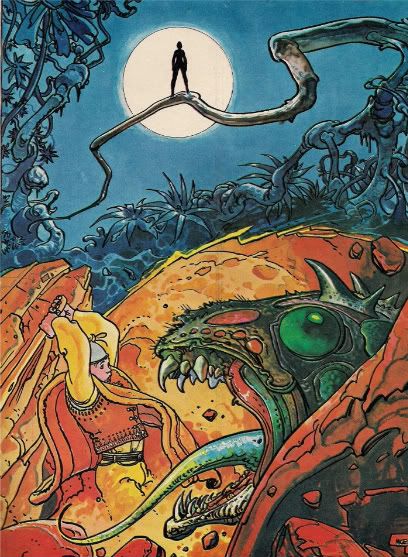
(Moebius; from Heavy Metal, Nov. 1977)
Les Humanoïdes Associés was formed in 1974. Present at the birth were the artists Jean "Moebius" Giraud and Philippe Druillet, the writer Jean-Pierre Dionnet and financier Bernard Farkas. Moebius was the best known of them in comics circles, although he was hardly known by that name at the time; it was the fit-for-kids Blueberry cowboy comics of 'Jean Giraud' that were renowned, while 'Moebius' was only glimpsed briefly in the pages of Hara-Kiri, a comics-friendly humor magazine for adults.
This bifurcation of identity suggests the tenor of the time. Moebius, Druillet and Dionnet were all contributors to Pilote, the popular French comics magazine begun in 1959 by writer Jean-Michel Charlier (who provided Giraud's Blueberry scripts), artist Jean Hébrard, and Astérix co-creators René Goscinny & Albert Uderzo. It was a children's thing, as were nearly all Franco-Belgian comics at the time of its debut, and you could understand a popular artist's desire to keep his oddball art by form and identity from his lush creations for all ages.
But the French scene changed as the '60s wore on; successful, high-profile works like Jean-Claude Forest's Barbarella and the Italian-born Hugo Pratt's Corto Maltese suggested broader possibilities in terms of content and format, and artists began to bump more against the limitations of children's comics, where restrain was encouraged and album-format publication was not assured. Pilote tried to adapt, but it couldn't provide a forum for the adult work many of its contributors wanted to produce, and a certain 'brain drain' began.
Notably, the departed artists Claire Bretécher, Marcel Gotlieb and Nikita Mandryka founded the sex & satire comics anthology L'Écho des Savanes in 1972; both Jean-Pierre Dionnet and Moebius would eventually contribute. The latter had already begun creating surreal, dynamic strips under the third name of 'Gir,' as if to signal a reluctance to part fully with his realist, all-ages identity.
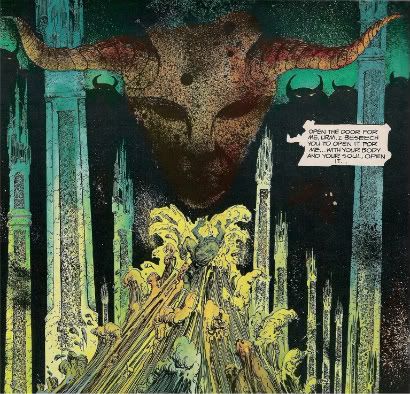
(Druillet; from Heavy Metal, May 1978)
There was less hesitation in '74, when Les Humanoïdes began, and with it the sci-fi/fantasy magazine Métal Hurlant. Moebius was soon Moebius, his lovely details rushing to the edges in favor of cartooned activity, like a curious reversal of the path of his mentor, the great Belgian cartoonist Jijé, who'd backed from his own Hergé-influenced style and built a realist image for the cowboy Jerry Spring, only to be later offered Blueberry, for which he recommended his student, who then broke his realism off into flowing, intuitive cartooning, which thrived at the break point from the golden age of Franco-Belgian children's comics that the teacher had witnessed. The end was the beginning.
Druillet changed a bit too, mind you; while not a model of minimalist nuance to start with, his storytelling (ironically) became less beholden to beloved space opera tropes, exploding into seething splashes and spreads, or wandering around in doodled thought, going just about wherever its most immediate emotions or notions demanded. This was the ideal of Métal Hurlant - it was sci-fi and fantasy, but hell, Pilote had published Lone Sloane and all. It wasn't just genre; it was the freedom to use genre as a means of expressing personal, expressive things, and to play with visuals and let the pour all over, to run around and find a wide and proper adulthood.
Obviously, Métal Hurlant was far from the first adult comics magazine in France. You could probably argue it wasn't the most sophisticated either, particularly given its proximity to the perhaps more literary-minded (À Suivre), established in 1978, with which it shared many contributors.
But it was the big international hit of the lot, at least for our purposes.
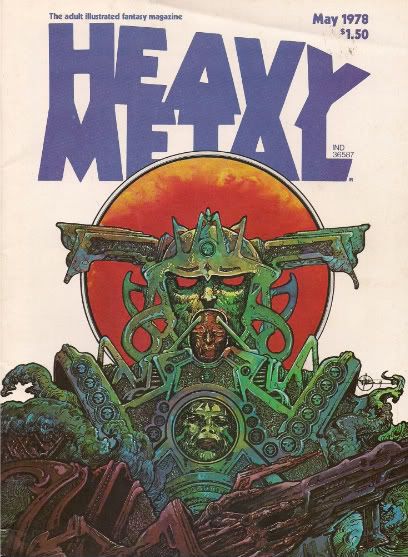
And wasn't it very, very lucky that Heavy Metal, Hurlant's National Lampoon-backed North American edition, started off in 1977, just in time to stretch out and serve as part of the 'bridge' works of U.S. comics, those post-underground, often genre-focused works that cropped up with the growth of the Direct Market? Oh, Heavy Metal showed up on plenty of newsstands -- it still does, and enjoys better availability than most back-of-Previews comics -- but it was comics, and it printed work by North American artists like Richard Corben (also a Hurlant import) and Howard Chaykin, and it was very much not Comics Code Approved.
It's actually kind of hilarious how popular Heavy Metal got. I mean, have you gone back recently and tried to actually read one of those '70s editions? That thing has to be among the most new reader unfriendly comics in the history of English. Whole issues went by composed of nothing but chapters from the middle of serials (and maybe a few pin-ups), with no synopses, no explanations, and often only part of the artists' names. 'Druillet.' 'Bilal.' 'Tardi.' Who the hell are these people?! Hey, if you don't like it, there's plenty of other magazines to read. That's the attitude I sensed.
Yet, I think that only helped. It's not that nobody in North America was aware of European comics at that time or anything, but the period was especially conductive to a little pantheon-building, a very special published presentation of a weird and exotic new comics culture, forbiddingly foreign (and sometimes questionably translated) but exciting. As if this is what American comics could be. It was the future, although the trouble with futures is that they're either fantasies or, eventually, the past.
Heavy Metal, the American magazine, was never actually owned by Les Humanoïdes, and it eventually grew apart from its French parent; amusingly, an attempt was made in the early '80s to create an English-language version of Pilote, to serve as Heavy Metal's younger-skewing sister magazine. Another circle. Nothing came of it.
Métal Hurlant ceased operations in 1987. The following year, Les Humanoïdes Associés was purchased by a young Swiss man, Fabrice Giger, who remains its publisher today.
In 1998, Humanoids Publishing was formed, as Les Humanoïdes' presence in American comics.
***
Miss: Better Living Through Crime
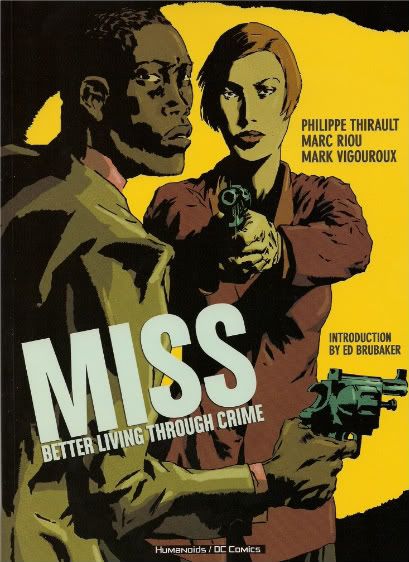
Oddly enough, the first Humanoids publication I can find any record for in English was a January 1999 book of Milo Manara's illustrations for the 1896 Pierre Louÿs novel Aphrodite: Ancient Manners - erotica, then.
It's odd because Humanoids' early years in America were marked by various and sundry attempts to adapt to the marketplace; it was no longer the '70s, and they couldn't just knock 'em out with a magazine. The year 2000 brought the first of a few attempts to serialize popular albums in the pamphlet format, an edition of Alejandro Jodorowsky's & Juan Giménez's The Metabarons that was edited by artist Giménez himself to remove all nudity from the work. This was characterized as essentially a concession to U.S. cultural (or at least U.S. comic book cultural) norms; one can presume that Humanoids was not out to risk any possible market penetration.
Humanoids also released some works in the oversized hardcover 'album' format, and performed some experiments with the U.S. trade paperback style. Among those experiments was the 2002 publication of Miss: Better Living Through Crime, a 1999-2002 series by writer Philippe Thirault and artists Marc Riou & Mark Vigouroux. It was an all-in-one package, albeit with the original color art converted to grayscale. I don't have a copy of this edition, and I can't find any record of why this decision was made. Was there some financial impetus? Unexpected problems with the source materials? Did they think it'd make the book more noir? It seems today like another strange effort to adapt to a marketplace no longer so friendly.
In 2004, however, the DC deal began; it's hard to imagine more raw potential for friendliness, given the long-ago solidified setup of the Direct Market. Suddenly, Humanoids softcovers were everywhere, filled with nakedness and prone to reprinting (with attempts at completion) series already covered a few years ago, in some other format, under more hazardous market conditions. The second edition of Miss appeared at the long end of the deal, in 2005, restored to its original color.
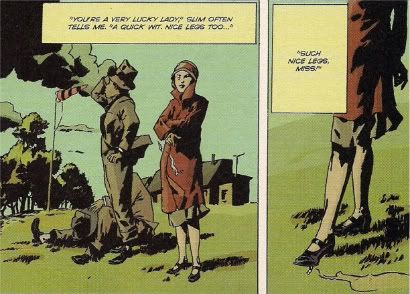
It also sported an introduction by Ed Brubaker, undated but apparently new to that edition. Brubaker was still in the midst of Season Two of his superhero spy series Sleeper at that time, and at (or just past) the tail end of runs on Gotham Central and Catwoman, while warming up his command of Captain America; he was known at the time (or so I remember it) for injecting superhero stories with crime and espionage elements that seemed to fit naturally. His first paragraph is telling:
"Working in the U.S. comics market, it's hard not to look at European comics with a sort of jealousy. The freedom that writers and artists have to explore so many different genres, in such nice packages, is certainly alluring when viewed from a place that is so dominated by one particular genre and style. One of my favorite genres, of course, which has thrived in European comics, and is finally starting to gain a hold in the American scene, is crime stories, and you'll be hard-pressed to find a more compelling example of a great crime story than MISS."
Put your ear up to that page, and you can hear Criminal simmering underneath the Batman-with-crime. He'd been there before, and he'd go there again.
But there's something else; a notion of European comics as not so much different or exotic or strange & enticing, but better. Not at all unlike U.S. comics, just improved. An alternate universe, born from better circumstances. Relatable. Manga wasn't quite a juggernaut in 2004, when I presume that was written, but it was getting there, and I daresay it'd seized the mantle of alien dazzle already, despite having lurked around the scene since shortly after Heavy Metal launched Eurocomics into the hotter heat.
Think about it. Rhetorically, comparatively, 'manga' is often swung as a cudgel. Manga is killing U.S. comics, and deservedly so, the babyman bastards! Manga is attracting the eyes of the young - our fault for being so boring! Manga is fat anthologies and bookshelf books, and so cheap and so diverse, and some people don't understand it at all, and some people back away from trying to understand it, because it's too vast.
I don't think French comics have that quality anymore, at least not in perception of the pop comics mainstream, related to the stuff that makes up most of the manga in Barnes and Noble and damn near everything in Heavy Metal today. Of course, part of that's due to the French 'mainstream' itself processing the qualities of 'mature' comics into more sedate or formulaic works; Moebius was part of the avant-garde, back in the '70s, and the crowd of works he left behind have since caught up to him, at least in 'all comics need not be fit for children' terms.
With manga, even the kids' comics seem dense with unfamiliarity, pulsing with formal eccentricities. There's a lot of the stuff published in France too, and I think the particulars of 'realist' pop comics between France and the U.S. seem a little closer together for its presence. And it therefore seems tempting, from the closeness, to think that these former solitudes could change one another. Or for greater responsivity to cohere.
Perhaps that was part of the DC/Humanoids deal - these pop comics kind of look like ours, and since manga is doing okay in bookshelf form being so different, maybe something a bit cozier could do all right as trade paperbacks? Heck, they were doing the same thing with Rebellion from the UK around the same time.
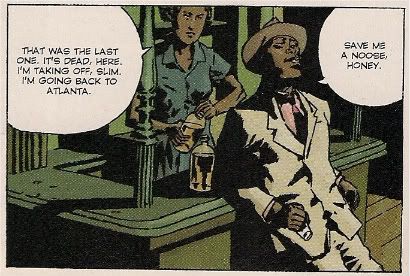
All of that's a laborious way of getting at the twist: how Humanoids, given access to the Direct Market, somehow sort of wound up showing off different approaches to European comics, even though I'm pretty sure it was DC asking for the titles to release. They did it without a lot of promotion, though; not every book had an Ed Brubaker hammering out a Foreword, and I suspect a lot of it just plain old got lost, without a lot of the finer distinctions drawn, or really much context given.
Miss, in case you were wondering, is a pretty fucking good crime comic, all things considered. Brubaker wasn't messing around up there. What stands out for me, though, is how different its approach is from nearly any U.S. crime comic I can think of, in spite of its New York setting and its zest for hard boiled narration ("You could tell Frank used to be a cop, 'cause he had no manners. Frank said the good ones quit, and the bad ones stayed cops. So Frank must have been right in the middle, because he left the force to become an investigator.") (translation by Justin Kelly & Natacha Ruck). It's more like the writing of Carlos Sampayo, writer of the investigator characters Alack Sinner (w' José Muñoz) and Evaristo (w' Francisco Solano López), whom Brubaker also cites, in terms of the cruel-yet-sympathetic nature of his casts.
Thirault also knows how to wander, though. The premise of Miss is simple - Nola is a poor young woman in the NYC of the 1920s who manages to finish off a murder-for-hire job that got her boss (see Frank, supra) killed, leading to more jobs, and Our Heroine's taking on the devil-may-care aid of Slim, a trouble-prone pimp. Yet for all four of the French volumes collected, there's never less than three or so plots staggering around, mildly disconnected scenes overlapping a tiny bit, but mostly grabbing primacy away from one another when the time is right, only for bits of earlier stories to pop up later for added impact.
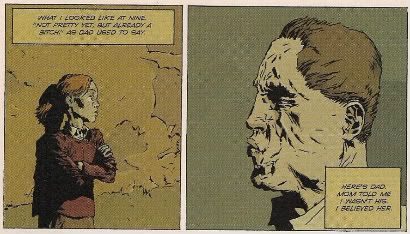
Always, there's a strong focus on family. Race too, and class, but mostly parents and children and spouses - a chapter might begin with the killers looking to bump off a young woman's ailing husband at sea, and end with a literal parent of one of the main characters being fished out of the water, having been killed by their child. In between, the cast drifts from job to job, visiting friends, recalling scenes from their lives, flirting and plotting; it's intimate, while allowing for many opportunities to show off various facets of the NYC diamond, from baptisms in the wharf to the "kennel" box seats for monied blacks at the theater.
It's pulpy, sure -- there's a knife fight with a wild man undergoing electroshock therapy, sniper hits on a golf course leading to all-out war with the Ku Klux Klan and a high melodrama grand finale that probably ties things up a bit too neatly -- but the emphasis in the title is as much on Living as Crime. Some sins against tight plotting are committed, yes, with place and mood and emotion set as the vice; you grow to understand the skewed moral code of these characters, picked up through the accumulation of their actions, a mix of doing what's right and getting things done to get to somewhere better.
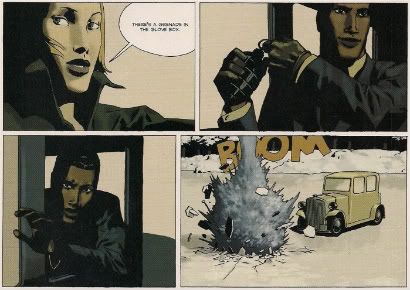
("There's a grenade in the glove box.")
You don't see a lot of this approach in domestic crime comics, this plot-by-the-multitudes and characterization via digression, and time taken out for odd jokes, like a ferret biting somebody's nose off. It rambles meaningfully, whirling through its themes for a while, clustering, then resting after adequate evocation. The art shifts noticeably as each volume passes; early pages have a contorted, mildly caricatured approach to the character art, everything melted and molded, a bit like Lee Bermejo's stuff. By the final volume, the coloring has suddenly moved into heavy digital textures covering model-like figures, mildly Corbenesque, but not as lively. Some of the action scenes lack clarity, or seem overly posed, particularly in those later portions.
Still, it gives the work a little extra dab of time passing, in the midst of a book wherein weeks might skip in between panels on the same page. The roaring '20s give way to the Depression, and even murder doesn't make a lot of money. Parents die, families break apart. It's never so much chapters as a story by way of collage, and I wonder if I'll see anything like that from those new crime books Vertigo is cooking up. Already there seems to be more attentiveness than there was with Humanoids!

For his part, publisher Giger does not consider the DC period to be a failure, preferring to characterize it as "a first step in a slow transformation within the US market." And it's true that Humanoids didn't so much as leave as go to sleep, poking an eye open every so often for an issue of Lucha Libre with Image.
But the Devil's Due books, the I Am Legion and The Zombies That Ate the World they have going are pamphlets (again), and small in number (again), and both were published in part with DC, back in the day.
The window for Humanoids is closed a bit, when it used to be wide open, along with the doors and the fence, and the shower curtain too. For a while, it was like we could see damn near everything they published. It was a nice place, but it wasn't ours. Thank heavens we have all the time in the world now to tour it, as history. I hope its luck is better now, as it's living.

(Moebius; from Heavy Metal, Nov. 1977)
Les Humanoïdes Associés was formed in 1974. Present at the birth were the artists Jean "Moebius" Giraud and Philippe Druillet, the writer Jean-Pierre Dionnet and financier Bernard Farkas. Moebius was the best known of them in comics circles, although he was hardly known by that name at the time; it was the fit-for-kids Blueberry cowboy comics of 'Jean Giraud' that were renowned, while 'Moebius' was only glimpsed briefly in the pages of Hara-Kiri, a comics-friendly humor magazine for adults.
This bifurcation of identity suggests the tenor of the time. Moebius, Druillet and Dionnet were all contributors to Pilote, the popular French comics magazine begun in 1959 by writer Jean-Michel Charlier (who provided Giraud's Blueberry scripts), artist Jean Hébrard, and Astérix co-creators René Goscinny & Albert Uderzo. It was a children's thing, as were nearly all Franco-Belgian comics at the time of its debut, and you could understand a popular artist's desire to keep his oddball art by form and identity from his lush creations for all ages.
But the French scene changed as the '60s wore on; successful, high-profile works like Jean-Claude Forest's Barbarella and the Italian-born Hugo Pratt's Corto Maltese suggested broader possibilities in terms of content and format, and artists began to bump more against the limitations of children's comics, where restrain was encouraged and album-format publication was not assured. Pilote tried to adapt, but it couldn't provide a forum for the adult work many of its contributors wanted to produce, and a certain 'brain drain' began.
Notably, the departed artists Claire Bretécher, Marcel Gotlieb and Nikita Mandryka founded the sex & satire comics anthology L'Écho des Savanes in 1972; both Jean-Pierre Dionnet and Moebius would eventually contribute. The latter had already begun creating surreal, dynamic strips under the third name of 'Gir,' as if to signal a reluctance to part fully with his realist, all-ages identity.

(Druillet; from Heavy Metal, May 1978)
There was less hesitation in '74, when Les Humanoïdes began, and with it the sci-fi/fantasy magazine Métal Hurlant. Moebius was soon Moebius, his lovely details rushing to the edges in favor of cartooned activity, like a curious reversal of the path of his mentor, the great Belgian cartoonist Jijé, who'd backed from his own Hergé-influenced style and built a realist image for the cowboy Jerry Spring, only to be later offered Blueberry, for which he recommended his student, who then broke his realism off into flowing, intuitive cartooning, which thrived at the break point from the golden age of Franco-Belgian children's comics that the teacher had witnessed. The end was the beginning.
Druillet changed a bit too, mind you; while not a model of minimalist nuance to start with, his storytelling (ironically) became less beholden to beloved space opera tropes, exploding into seething splashes and spreads, or wandering around in doodled thought, going just about wherever its most immediate emotions or notions demanded. This was the ideal of Métal Hurlant - it was sci-fi and fantasy, but hell, Pilote had published Lone Sloane and all. It wasn't just genre; it was the freedom to use genre as a means of expressing personal, expressive things, and to play with visuals and let the pour all over, to run around and find a wide and proper adulthood.
Obviously, Métal Hurlant was far from the first adult comics magazine in France. You could probably argue it wasn't the most sophisticated either, particularly given its proximity to the perhaps more literary-minded (À Suivre), established in 1978, with which it shared many contributors.
But it was the big international hit of the lot, at least for our purposes.

And wasn't it very, very lucky that Heavy Metal, Hurlant's National Lampoon-backed North American edition, started off in 1977, just in time to stretch out and serve as part of the 'bridge' works of U.S. comics, those post-underground, often genre-focused works that cropped up with the growth of the Direct Market? Oh, Heavy Metal showed up on plenty of newsstands -- it still does, and enjoys better availability than most back-of-Previews comics -- but it was comics, and it printed work by North American artists like Richard Corben (also a Hurlant import) and Howard Chaykin, and it was very much not Comics Code Approved.
It's actually kind of hilarious how popular Heavy Metal got. I mean, have you gone back recently and tried to actually read one of those '70s editions? That thing has to be among the most new reader unfriendly comics in the history of English. Whole issues went by composed of nothing but chapters from the middle of serials (and maybe a few pin-ups), with no synopses, no explanations, and often only part of the artists' names. 'Druillet.' 'Bilal.' 'Tardi.' Who the hell are these people?! Hey, if you don't like it, there's plenty of other magazines to read. That's the attitude I sensed.
Yet, I think that only helped. It's not that nobody in North America was aware of European comics at that time or anything, but the period was especially conductive to a little pantheon-building, a very special published presentation of a weird and exotic new comics culture, forbiddingly foreign (and sometimes questionably translated) but exciting. As if this is what American comics could be. It was the future, although the trouble with futures is that they're either fantasies or, eventually, the past.
Heavy Metal, the American magazine, was never actually owned by Les Humanoïdes, and it eventually grew apart from its French parent; amusingly, an attempt was made in the early '80s to create an English-language version of Pilote, to serve as Heavy Metal's younger-skewing sister magazine. Another circle. Nothing came of it.
Métal Hurlant ceased operations in 1987. The following year, Les Humanoïdes Associés was purchased by a young Swiss man, Fabrice Giger, who remains its publisher today.
In 1998, Humanoids Publishing was formed, as Les Humanoïdes' presence in American comics.
***
Miss: Better Living Through Crime

Oddly enough, the first Humanoids publication I can find any record for in English was a January 1999 book of Milo Manara's illustrations for the 1896 Pierre Louÿs novel Aphrodite: Ancient Manners - erotica, then.
It's odd because Humanoids' early years in America were marked by various and sundry attempts to adapt to the marketplace; it was no longer the '70s, and they couldn't just knock 'em out with a magazine. The year 2000 brought the first of a few attempts to serialize popular albums in the pamphlet format, an edition of Alejandro Jodorowsky's & Juan Giménez's The Metabarons that was edited by artist Giménez himself to remove all nudity from the work. This was characterized as essentially a concession to U.S. cultural (or at least U.S. comic book cultural) norms; one can presume that Humanoids was not out to risk any possible market penetration.
Humanoids also released some works in the oversized hardcover 'album' format, and performed some experiments with the U.S. trade paperback style. Among those experiments was the 2002 publication of Miss: Better Living Through Crime, a 1999-2002 series by writer Philippe Thirault and artists Marc Riou & Mark Vigouroux. It was an all-in-one package, albeit with the original color art converted to grayscale. I don't have a copy of this edition, and I can't find any record of why this decision was made. Was there some financial impetus? Unexpected problems with the source materials? Did they think it'd make the book more noir? It seems today like another strange effort to adapt to a marketplace no longer so friendly.
In 2004, however, the DC deal began; it's hard to imagine more raw potential for friendliness, given the long-ago solidified setup of the Direct Market. Suddenly, Humanoids softcovers were everywhere, filled with nakedness and prone to reprinting (with attempts at completion) series already covered a few years ago, in some other format, under more hazardous market conditions. The second edition of Miss appeared at the long end of the deal, in 2005, restored to its original color.

It also sported an introduction by Ed Brubaker, undated but apparently new to that edition. Brubaker was still in the midst of Season Two of his superhero spy series Sleeper at that time, and at (or just past) the tail end of runs on Gotham Central and Catwoman, while warming up his command of Captain America; he was known at the time (or so I remember it) for injecting superhero stories with crime and espionage elements that seemed to fit naturally. His first paragraph is telling:
"Working in the U.S. comics market, it's hard not to look at European comics with a sort of jealousy. The freedom that writers and artists have to explore so many different genres, in such nice packages, is certainly alluring when viewed from a place that is so dominated by one particular genre and style. One of my favorite genres, of course, which has thrived in European comics, and is finally starting to gain a hold in the American scene, is crime stories, and you'll be hard-pressed to find a more compelling example of a great crime story than MISS."
Put your ear up to that page, and you can hear Criminal simmering underneath the Batman-with-crime. He'd been there before, and he'd go there again.
But there's something else; a notion of European comics as not so much different or exotic or strange & enticing, but better. Not at all unlike U.S. comics, just improved. An alternate universe, born from better circumstances. Relatable. Manga wasn't quite a juggernaut in 2004, when I presume that was written, but it was getting there, and I daresay it'd seized the mantle of alien dazzle already, despite having lurked around the scene since shortly after Heavy Metal launched Eurocomics into the hotter heat.
Think about it. Rhetorically, comparatively, 'manga' is often swung as a cudgel. Manga is killing U.S. comics, and deservedly so, the babyman bastards! Manga is attracting the eyes of the young - our fault for being so boring! Manga is fat anthologies and bookshelf books, and so cheap and so diverse, and some people don't understand it at all, and some people back away from trying to understand it, because it's too vast.
I don't think French comics have that quality anymore, at least not in perception of the pop comics mainstream, related to the stuff that makes up most of the manga in Barnes and Noble and damn near everything in Heavy Metal today. Of course, part of that's due to the French 'mainstream' itself processing the qualities of 'mature' comics into more sedate or formulaic works; Moebius was part of the avant-garde, back in the '70s, and the crowd of works he left behind have since caught up to him, at least in 'all comics need not be fit for children' terms.
With manga, even the kids' comics seem dense with unfamiliarity, pulsing with formal eccentricities. There's a lot of the stuff published in France too, and I think the particulars of 'realist' pop comics between France and the U.S. seem a little closer together for its presence. And it therefore seems tempting, from the closeness, to think that these former solitudes could change one another. Or for greater responsivity to cohere.
Perhaps that was part of the DC/Humanoids deal - these pop comics kind of look like ours, and since manga is doing okay in bookshelf form being so different, maybe something a bit cozier could do all right as trade paperbacks? Heck, they were doing the same thing with Rebellion from the UK around the same time.

All of that's a laborious way of getting at the twist: how Humanoids, given access to the Direct Market, somehow sort of wound up showing off different approaches to European comics, even though I'm pretty sure it was DC asking for the titles to release. They did it without a lot of promotion, though; not every book had an Ed Brubaker hammering out a Foreword, and I suspect a lot of it just plain old got lost, without a lot of the finer distinctions drawn, or really much context given.
Miss, in case you were wondering, is a pretty fucking good crime comic, all things considered. Brubaker wasn't messing around up there. What stands out for me, though, is how different its approach is from nearly any U.S. crime comic I can think of, in spite of its New York setting and its zest for hard boiled narration ("You could tell Frank used to be a cop, 'cause he had no manners. Frank said the good ones quit, and the bad ones stayed cops. So Frank must have been right in the middle, because he left the force to become an investigator.") (translation by Justin Kelly & Natacha Ruck). It's more like the writing of Carlos Sampayo, writer of the investigator characters Alack Sinner (w' José Muñoz) and Evaristo (w' Francisco Solano López), whom Brubaker also cites, in terms of the cruel-yet-sympathetic nature of his casts.
Thirault also knows how to wander, though. The premise of Miss is simple - Nola is a poor young woman in the NYC of the 1920s who manages to finish off a murder-for-hire job that got her boss (see Frank, supra) killed, leading to more jobs, and Our Heroine's taking on the devil-may-care aid of Slim, a trouble-prone pimp. Yet for all four of the French volumes collected, there's never less than three or so plots staggering around, mildly disconnected scenes overlapping a tiny bit, but mostly grabbing primacy away from one another when the time is right, only for bits of earlier stories to pop up later for added impact.

Always, there's a strong focus on family. Race too, and class, but mostly parents and children and spouses - a chapter might begin with the killers looking to bump off a young woman's ailing husband at sea, and end with a literal parent of one of the main characters being fished out of the water, having been killed by their child. In between, the cast drifts from job to job, visiting friends, recalling scenes from their lives, flirting and plotting; it's intimate, while allowing for many opportunities to show off various facets of the NYC diamond, from baptisms in the wharf to the "kennel" box seats for monied blacks at the theater.
It's pulpy, sure -- there's a knife fight with a wild man undergoing electroshock therapy, sniper hits on a golf course leading to all-out war with the Ku Klux Klan and a high melodrama grand finale that probably ties things up a bit too neatly -- but the emphasis in the title is as much on Living as Crime. Some sins against tight plotting are committed, yes, with place and mood and emotion set as the vice; you grow to understand the skewed moral code of these characters, picked up through the accumulation of their actions, a mix of doing what's right and getting things done to get to somewhere better.

("There's a grenade in the glove box.")
You don't see a lot of this approach in domestic crime comics, this plot-by-the-multitudes and characterization via digression, and time taken out for odd jokes, like a ferret biting somebody's nose off. It rambles meaningfully, whirling through its themes for a while, clustering, then resting after adequate evocation. The art shifts noticeably as each volume passes; early pages have a contorted, mildly caricatured approach to the character art, everything melted and molded, a bit like Lee Bermejo's stuff. By the final volume, the coloring has suddenly moved into heavy digital textures covering model-like figures, mildly Corbenesque, but not as lively. Some of the action scenes lack clarity, or seem overly posed, particularly in those later portions.
Still, it gives the work a little extra dab of time passing, in the midst of a book wherein weeks might skip in between panels on the same page. The roaring '20s give way to the Depression, and even murder doesn't make a lot of money. Parents die, families break apart. It's never so much chapters as a story by way of collage, and I wonder if I'll see anything like that from those new crime books Vertigo is cooking up. Already there seems to be more attentiveness than there was with Humanoids!

For his part, publisher Giger does not consider the DC period to be a failure, preferring to characterize it as "a first step in a slow transformation within the US market." And it's true that Humanoids didn't so much as leave as go to sleep, poking an eye open every so often for an issue of Lucha Libre with Image.
But the Devil's Due books, the I Am Legion and The Zombies That Ate the World they have going are pamphlets (again), and small in number (again), and both were published in part with DC, back in the day.
The window for Humanoids is closed a bit, when it used to be wide open, along with the doors and the fence, and the shower curtain too. For a while, it was like we could see damn near everything they published. It was a nice place, but it wasn't ours. Thank heavens we have all the time in the world now to tour it, as history. I hope its luck is better now, as it's living.
Labels: Hurlant

<< Home